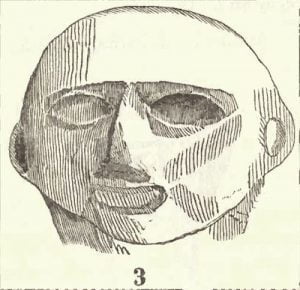
While I was engaged in taking the census of the Onondagas, at their council house, at the Castle, where a large number of all ages and both sexes were assembled, the interpreter, who spoke English very well, taking advantage of a pause in the business, said to me, pointing to a fine boy who sat on a bench, near a window, “that is our king!” I had, a short time before, requested that this boy should be sent for. His mother had now, unperceived by me, brought him, dressed out in his best clothes, and evinced, by the expression of her eyes and bearing, a conscious pride in bringing him to my notice. And truly, she had every reason to be proud of so finely formed, bright and well-looking a boy. In addition to these advantages, it is to be remembered that descent, amongst the Onondagas and the other Iroquois, is counted by the female, which constituted a further motive of satisfaction and pride to the mother, in showing her pretty Hux-sa-ha, or boy. She made no remark, however, on my noticing him, but sat with modesty and ease near him, but with an eye beaming with too much pride and self-complacence to be concealed.
The lad was but three years old, but tall for that age, and offered a fine model of form. I could not help noticing, what had often impressed me in similar instances, that the infusion of European blood, derived from his grandfather by the father’s side, had served to heighten and improve physical development, and fullness and beauty of muscle. His eyes were full, large, black and sparkling. His dark hair also was a true trait of his race. His countenance was of a bright brown, showing the blood, and rather formed on the Grecian mould, with a good nose and pretty lips. Yet, over all, there was a physiological dash of the muscular expression, hue and air of the true Konoshioni.
There was nothing peculiar in his dress, which was of good materials and well made, agreeably to the nation’s fashion for boys, except it might be the lining of the under brim of a light straw hat, which the mother had carefully decorated with a piece of light figured cotton goods, looking as if it had been cut from a printed handkerchief.
I did not think to ask the name of this promising young candidate for the seat and honors of the Atotarho, or chief magistracy of his nation. His father’s name is Tso-ha-neeh-sa, which, according to the curious principles of naming persons, and the still more curious rules of the Indian syntax, means a road, the receding parallel lines of which intermingle by atmospheric refraction. This, apparently to them, mysterious uniting and separating of the lines in such a vista, is the idea described by this compound term. The boy, however, inherits, or has the right of inheritance of the Atotarho, not “a king,” through the mother, who was a daughter of the principal Ho-ai-ne, or chief. This daughter was married to Ezekiel Webster, an American, a New Englander, a Vermonter, I think, who either by freak, taste or fortune, wandered off among the Iroquois soon after the close of the American revolution, and finally fixed himself in the Onondaga valley, where he learned the language, established a trade in the gensing root, and became a man of note and influence in the tribe. He died in old age, and is buried in this valley, where he has left sons and daughters, all of whom, however, are recognized as members of the ancient Onondaga canton, or People of the Hills.
